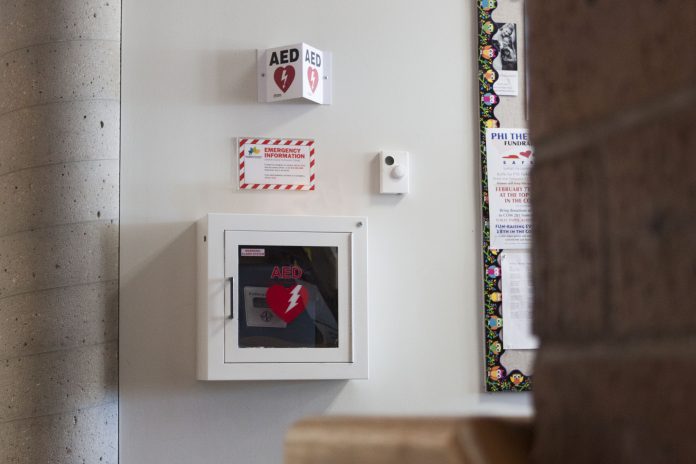
Kim Harms
News editor
February is Heart Health Month and spreading awareness is more important than ever since heart disease remains the leading cause of death in both men and women in the United States.
Colleen Duggan, nursing professor, said knowing which risk factors apply to you can help determine which prevention measures to take. Learning how to reduce certain risk factors can significantly lower the possibility of developing heart disease.
“There are [risk factors] you can’t do anything about,” Duggan said. “The ones that you can’t change would be age, what sex you are, your heredity and ethnicity. There are other [risk factors] that we can change. We want to look at our diet and the things we can start to eliminate such as soda. Secondly, we should be looking at processed foods which is anything that come in a package and has been processed. Those foods tend to have a lot of salt and other unhealthy additives to them.”
The right amount of exercise is just as important for heart disease prevention as a healthy diet. Making small changes, such as walking extra steps everyday can count towards a weekly exercise goal.
“We would like for everyone to have at least 150 minutes of exercise a week, that’s what the American Heart Association asks us to do,” Duggan said. “Even small amounts of exercise count. It might be taking the stairs instead of the elevator, or taking study for ten minutes to go walking. It might be doing five squats during class breaks, everything helps.”
One of the most important risk factors for heart disease is family history. Those with a family history of heart disease should let their physician know so they can take appropriate preventative steps such as routine testing.
“Family history is so important in cardiac disease,” Duggan said. “I work on a cardiac unit at the hospital with my students and one of things I always suggest to them when their patient is going for a test is, always ask if there are any family members with cardiac disease. When was it diagnosed, was it a heart attack at age 40? That’s more important than a a heart attack at the age 70. If someone has a very high risk of cardiac disease in their family then its important to have a stress test and an electrocardiogram done at a younger age along with all of the other tests.”
Family history of diabetes is a high risk factor for heart disease. Duggan said getting blood sugar levels checked frequently is recommended for those with diabetes in the family.
“It is important that if there is a history of diabetes in the family that everyone gets tested frequently for something called hemoglobin A1c,” Duggan said. “That tells us what the blood sugar has been running over the past two to three years. There are things that we can do to try to uncover what are those risk factors we need to pay attention to. It’s not only do we have heart disease in the family but do we have diabetes in the family as well.”
Gratitude is another way to help reduce the risk of heart disease because it is a form of stress management. Acknowledging the small accomplishments you’ve made daily and recognizing the people you care about can count as gratitude. Ruth Dey, wellness coordinator, discussed gratitude during the Love Your Heart lecture last Monday.
“Gratitude, believe it or not, is huge,” Dey said. “Clinical trials indicate that the practice of gratitude can have traumatic and lasting effects in a person’s life. It can lower blood pressure and improve the immune function. Grateful people engage in more exercise, have better dietary behaviors and are less like to smoke or abuse alcohol.”
Knowing the signs and symptoms of a heart attack or stroke is just as important as prevention. Warning signs such as severe chest pain, shortness breath and nausea can start slowly with mild pain and progress to a more intense pain. Recognizing those warning signs can help when someone is in need of immediate medical attention.
“[Signs and symptoms] of a stroke are slurred speech and one side of the face is numb,” Dey said. “They could be conscious so you may not have to do CPR on them, but what do you have to do? Call 911 if you’re off campus or 411 if you’re [on campus].”
Cardiopulmonary resuscitation (CPR) training can help in emergencies where medical attention is needed but help has not arrived yet. Hands-only CPR is one of the most effective methods compared to other methods such as mouth-to-mouth. Dey recommended when performing CPR to press down on the heart to the beat of “Stayin’ Alive” by the Bee Gees.
“Hands-only CPR is the big one for generally population, you can teach that to anybody,” Dey said. “[The individual] has to be on ground, they cannot be on a bed or a table. Clasp your fingers, press through the heel of your hand and line up your wrists and your shoulders. Press down through the heel of hand about two inches. Keep doing that until [medical assistance] arrives.”
Taking preventative steps and knowing the warning signs of a heart attack or stroke are beneficial not just during February, but also year-round. To learn more about heart disease click here. If you find yourself in a situation that requires drastic measures, the locations of the Automated External Defibrillators (AEDs) can be found here.





















